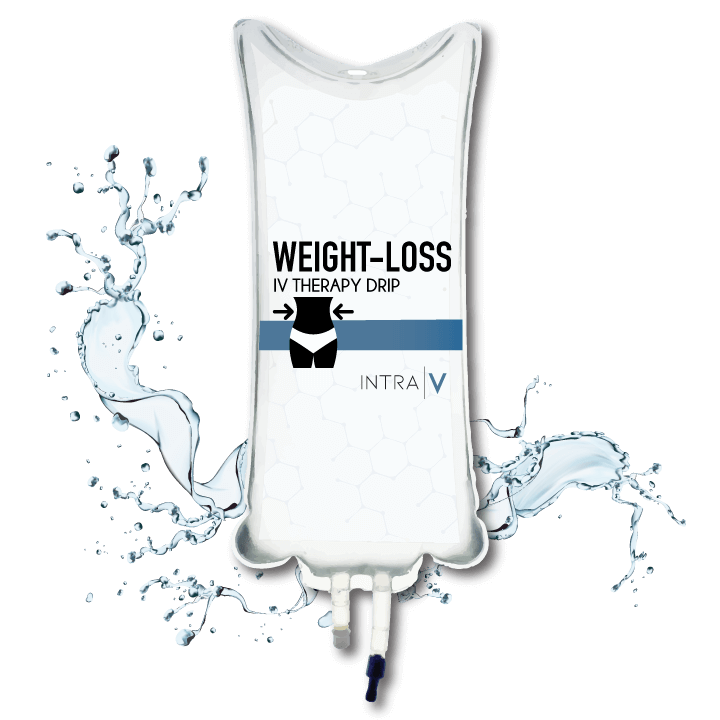Achieve Your Weight Loss Goals with Our vitamin iv Therapy
MELT THOSE EXTRA POUNDS
____
Needing to drop a few pounds? Want to get back your beach body? Our Weight-loss Drip in combination with a healthy diet and exercise can help achieve those goals. Our Weight-loss Vitamin IV Infusion is formulated to stimulate your metabolism, helps use stored fat and build lean muscle.
BENEFITS:
Fat Loss
Hydration
Increase Metabolism
Increase Kidney Function
Replenish Electrolytes
OTHER OPTIONS
MYERS IV COCKTAIL - The original multi-vitamin infusion enhances both body and mind.
NAD+ INFUSION - Get clear and focused. This effective combination is like a reboot for your brain.
ANTI AGING DRIP - This vitamin iv infusion smooths, plumps, lightens and brightens your skin with results you can see.
CUSTOM IV DRIP - Tell us what you’re trying to improve and our team will design a drip tailored to your specific needs.
GEEK OUT
Our Weight-loss Vitamin Therapy is a custom formula that includes a lipotropic (M.I.C) used to promote body fat reduction and preserve lean muscle tissue. M.I.C can also be used to maintain healthy liver function and protect the liver from disease. Combining this drip with B vitamins and Carnitine helps your body to metabolize faster and with a healthy diet and exercise program.
OUR WEIGHT LOSS DRIP CONTAINS:
-
As noted above, B complex will help potentiate the metabolism of fatty acids once they are mobilized by M.I.C. The body will need extra B vitamins in order to metabolize the increased fatty acids that have been mobilized and ready for use of ATP production (Energy).
-
Vitamin B12 is an essential vitamin that’s crucial for many vital metabolic and hormonal functions — including the production of digestive enzymes and carrying important nutrients into and out of cells. Due to how it helps convert and synthesize many other compounds within the body, it’s needed for well over 100 daily functions. Some of the roles that are attributed to vitamin B12 include: red blood cell production, DNA/RNA synthesis, methylation and producing the coating of the nerves.
-
Levocarnitine (L-3-hydroxy-4-N-trimethylaminobutyrate) is synthesized in the liver from the amino acids methionine and lysine. This naturally occurring substance is found in all mammalian tissues, especially striated muscle, and is required in energy metabolism, such as the oxidation of fatty acids, facilitating the aerobic metabolism of carbohydrates, and enhancing the excretion of certain organic acids. While only the L isomer is present in the biologic system, commercial synthesis of carnitine produces a D,L racemic mixture, from which the L-isomer is obtained. The D-isomer has pharmacologic effects but does not participate in lipid metabolism. Commercially, carnitine is available as both a prescription and non-prescription product. The prescription version is levocarnitine, while most dietary supplements contain D,L-carnitine which is commonly sold in health food stores.
Levocarnitine has been used in the treatment of primary and secondary carnitine deficiency in adults and neonates, Alzheimer's disease, dilated cardiomyopathy in adults and children, valproic acid-induced hepatotoxicity in children, and hyperlipoproteinemia. It has been designated an orphan drug for a variety of conditions. Its use in alcohol induced fatty liver, Down's syndrome, and chronic fatigue syndrome has shown varying results. Some athletes use carnitine supplements to increase exercise performance, however, the concept of carnitine loading does not appear to be very effective.1 Further, D,L-carnitine competitively inhibits levocarnitine. This inhibition may lead to a deficiency. Prescription forms of levocarnitine were approved by the FDA in 1985 (tablets), 1986 (oral solution), and 1992 (injection).
Mechanism of Action: Levocarnitine facilitates long-chain fatty acid transport from the cytosol to the mitochondria, providing substrates for oxidation and subsequent cellular energy production. Levocarnitine can promote the excretion of excess organic or fatty acids in patients with defects in fatty acid metabolism or specific organic acidopathies that bioaccumulate acyl CoA esters. Levocarnitine clears the acyl CoA esters by formation of acylcarnitine which is rapidly excreted.
Carnitine acetyltransferases (CATs) catalyze the interconversion of fatty acid esters of coenzyme A and carnitine, which are located in the cytosol and mitochondrial membranes. Translocases, which exist in mitochondrial membranes, rapidly transport both free carnitine and its esters in and out of cells. Fatty acid esters of CoA, formed in the cytosol, inhibit enzymes of the Krebs cycle, and are involved in oxidative phosphorylation. Hence, the oxidation of fatty acids requires the formation of acylcarnitines and their translocation into mitochondria where the CoA esters are reformed and metabolized. If oxygen tension is limited, carnitine serves to maintain a ratio of free to esterified CoA within mitochondria that is optimal for oxidative phosphorylation and for the consumption of acetyl CoA.
-
Lipo is a mixture of compounds that may aid in the reduction of adipose tissue (fat). The mixture of compounds individually may be effective, however in combination they may exhibit more lipotropic activity than when administered alone in a synergistic fashion. Injection of this mixture of lipotropic compounds may be more effective than oral supplementation, this is due to the increased bioavailability of parenteral exposure.
These lipotropic agents are structurally and functionally closely related to the B-vitamins, or are involved in the homeostasis of energy production from fat. These compounds are often employed together in the hope of potentiating fat-loss, thus while the MIC mixture and B vitamin(s) are often injected separately, they are part of the same overall injection cycle. The non-vitamin compounds (MIC) that are injected into the body stimulate the liver into optimizing the process of metabolism, elevate the movement of and utilization of fat, and provide the needed metabolic environment of the body for a fatty acid (fat) mobilization and utilization.
Lipotropic compounds are used to increase the potential for release of fat deposits in some parts of the body. The lipotropic agents included in this injection are:
Methionine helps the liver maintain the optimal ability to process fatty acids. Methionine is a major constituent of Sadenosylmethionine which has been shown to be associated in genetic regulation and activation of certain genes. Methionine contributes to methyl donation to histones that activate certain genetic processes that may be involved in the increase in lean tissue. Although indirectly linked to lipolysis, it is believed that the increase in lean tissue increases resting metabolic rate, therefore increasing the overall required calories that must be obtained from storage or dietary intake. Methionine, via Sadenosylmethionine, has been shown in animal models to increase CNS activity, therefore increasing the caloric requirements required by the CNS3. The downstream effects of this may ultimately lead to increased caloric requirements for the entire organism. Although studies have not been replicated in humans, there may be an association due to the similarity in pathways shared between organisms.
Inositol is a sugar-like molecule, referred to as a sugar alcohol. Even though very similar in molecular structure to glucose, this molecule does not exhibit the traits that simple carbohydrates exhibit. Contrary to simple carbohydrates, this sugar alcohol has been shown to not actively increase adipose storage. In fact, Inositol has been found to decrease fatty acid synthase activity, a multi-enzyme protein that catalyzes fatty acid synthesis. This set of enzymes ultimately enables the body to produce triglycerides fat molecules that reside in adipose tissue (body fat). Inositol may be effective in reducing insulin resistance, a common condition associated with increase adiposity (body fat). Insulin resistance, a condition to which your body becomes resistant to the activities of the hormone insulin. This condition leads to excess blood glucose levels and a host of symptoms and dysfunctions. A chemical called Inositol phosphoglycan is known to regulate the body’s sensitivity to insulin signaling. Inositol phosphoglycan structurally incorporates Inositol, thus inositol is required for this molecule to exert its regulating behavior.
The proper functioning and sensitivity to insulin is found in most healthy individuals, and is essential in maintaining overall health. Excessive exposure to blood glucose ultimately leads to insulin resistance and poor nutrient transport. Inositol may be effective in reducing this condition while at the same time reducing fatty acid (fat) synthesis.Choline is a simple molecule usually classified as a B vitamin. The B vitamin class is usually involved in the generation of energy and support of metabolism. Choline is an important precursor to the neurotransmitter acetylcholine. This neurotransmitter is involved in a host of activities, one of which includes muscular function and contraction. Acetylcholine is a fundamental neurotransmitter that enables the communication between neurons. Increased neural communication results in increased CNS activity which ultimately leads to increased energy expenditure. Energy expenditure requires nutrient input, either from stored energy (fat), or dietary nutrients. Choline exist in a delicate balance and homeostasis with methionine and folate. When these nutrients are not in balance adverse health effects may be present. Along with the increase in CNS activity comes increased cognitive ability, reported by many users. Choline may be effective as a nootropic, or a substance with ability to increase cognition. Increased neural cognition is thought to be due to choline’s role as a precursor to acetylcholine.
The supplementation of choline has been shown to reduce serum and urinary carnitine. The reduction of carnitine in these fluids may indicate carnitine has been partitioned in tissues that utilize it as a fatty acid mitochondrial transport. When carnitine is used in the mitochondria it transports fatty acids to the location which they are broken down and used as energy. It has also been reported that molecular fragments of fat have been found in urine after carnitine and choline supplementation, which may be due to incomplete fatty acid oxidation and the removal of the subsequent byproducts. This means, choline supplementation may increase the utilization of carnitine and increase the removal of fatty acids, even though all fatty acids are not burned as energy. The fragments of fatty acids not burned as energy are extruded in the urine as molecular fragments.
TESTIMONIALS

